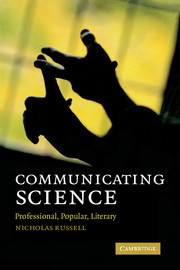Book contents
- Frontmatter
- Contents
- Introduction: What this book is about and why you might want to read it
- Prologue: Three orphans share a common paternity: professional science communication, popular journalism and literary fiction are not as separate as they seem
- Part I Professional science communication
- Part II Science for the public: what science do people need and how might they get it?
- Part III Popular science communication: the press and broadcasting
- 10 What every scientist should know about the mass media
- 11 What every scientist should know about journalists
- 12 The influence of new media
- 13 How the media represent science
- 14 How should science journalists behave?
- Part IV The origins of science in cultural context: five historic dramas
- Part V Science in literature
- Index
- References
12 - The influence of new media
Published online by Cambridge University Press: 02 December 2010
- Frontmatter
- Contents
- Introduction: What this book is about and why you might want to read it
- Prologue: Three orphans share a common paternity: professional science communication, popular journalism and literary fiction are not as separate as they seem
- Part I Professional science communication
- Part II Science for the public: what science do people need and how might they get it?
- Part III Popular science communication: the press and broadcasting
- 10 What every scientist should know about the mass media
- 11 What every scientist should know about journalists
- 12 The influence of new media
- 13 How the media represent science
- 14 How should science journalists behave?
- Part IV The origins of science in cultural context: five historic dramas
- Part V Science in literature
- Index
- References
Summary
In the City of London there is a statue of a city trader 1980s style, a yuppie from the early years of deregulated financial markets. What marks him out as a figure from history is the brick-sized mobile phone clasped to his ear. The early cell phone was large, expensive, ostentatious and used by loud-mouthed young men to keep ‘in touch’ with office or trading floor. The devices (and their owners) proved a major irritant when used on commuter trains to activate their partners to pick them up from the station.
Then the phones began to shrink and got much cheaper. While their capacity to irritate did not decrease, their value for gossip increased sharply, especially when teenagers discovered text messaging. My class of Science Communication students circa 1996/97 marked an early stage in this transition of the mobile phone from braying yuppie accessory to necessary adjunct to social life. One young woman, after agonizing for weeks, decided it was worth investing in a mobile. There may have been other early adopters in her class, but the excitement caused by her decision suggests that many still found the idea of owning a mobile phone outrageous.
By 2000 it was unusual if a student did not have a mobile phone, two or three years more and most owned camera phones. Two or three years more and most of them could send photographs to their friends and on the most expensive services could get (not-too-good) internet access. By late 2008 so-called 3G (third-generation) phones were the norm as universal communication and data-processing devices; simultaneously phones, cameras, video cameras, MP3 audio players, text-generators, e-mail and internet accessible. […]
- Type
- Chapter
- Information
- Communicating ScienceProfessional, Popular, Literary, pp. 161 - 171Publisher: Cambridge University PressPrint publication year: 2009



